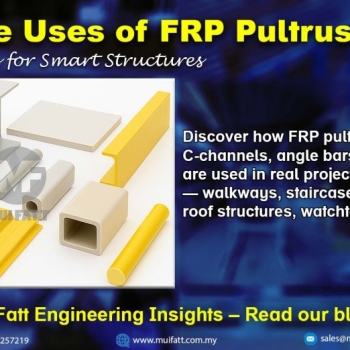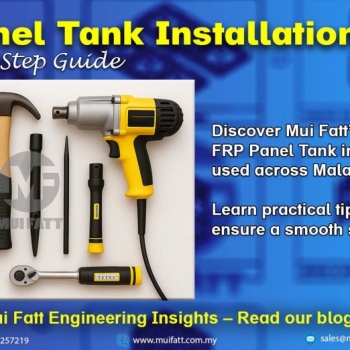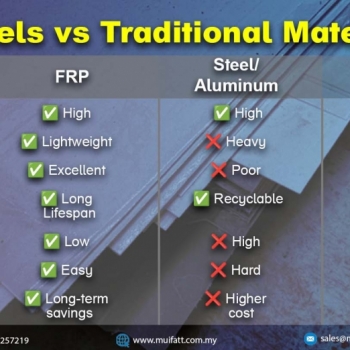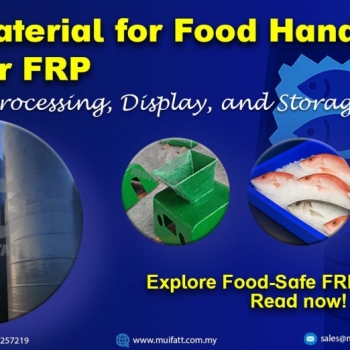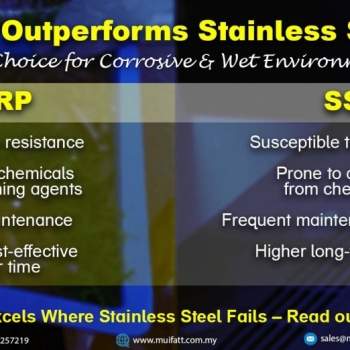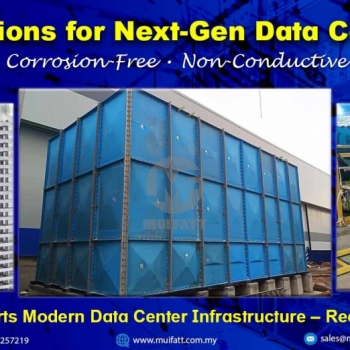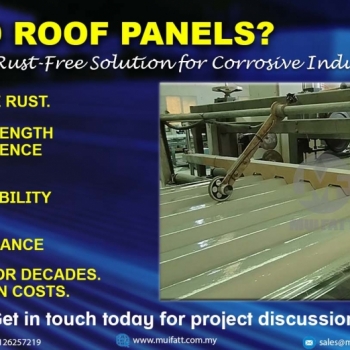FRP pultruded profiles are reshaping structural possibilities across Malaysia. From STP staircases to public park shelters, explore how these modular components enable custom FRP solutions—only from Mui Fatt.
Comparing FRP Waterproofing with Traditional Systems
28 May 2025
- Key Takeaways
- What is FRP Lamination?
- Is FRP Lamination a New Waterproofing Method?
- Common Types of Conventional Waterproofing Systems
- FRP vs Conventional Waterproofing: Comparison Table
- Benefits of FRP Lamination
- Where is FRP Waterproofing Used?
- Project Reference: FRP Lamination at Bandar Utama
- Frequently Asked Questions (FAQs)
- How long does FRP lamination last?
- Can FRP be applied over existing coatings?
- Is FRP lamination safe for potable water zones?
- Does FRP require regular recoating like PU?
- Is FRP lamination suitable for exposed outdoor areas?
- Can FRP lamination be repaired if damaged?
- How long does FRP lamination take to install?
- Does FRP lamination emit strong fumes during installation?
Key Takeaways
-
FRP lamination delivers superior chemical and structural durability in harsh environments.
-
It offers seamless and long-lasting waterproofing with minimal maintenance.
-
FRP is especially suitable for rooftops, tanks, chemical zones, and aquaponic systems.
-
Mui Fatt’s successful lamination project at Bandar Utama demonstrates its scalability.
Waterproofing is crucial in extending the lifespan of structures exposed to water, chemicals, or humidity. While traditional waterproofing systems like membranes and coatings have been used for decades, fiberglass-reinforced plastic (FRP) lamination is emerging as a durable and chemical-resistant alternative, especially in demanding environments.
What is FRP Lamination?
FRP lamination is a process where resin-saturated fiberglass mats are manually layered onto a surface using the hand lay-up method. Once cured, the result is a seamless, high-strength, chemical-resistant surface that adheres directly to concrete, metal, or wood.
This makes it ideal for waterproofing surfaces that require structural support, chemical exposure resistance, or a long service life.
Is FRP Lamination a New Waterproofing Method?
While FRP has long been used in industrial applications such as tanks, pipes, and structural reinforcements, its adoption as a primary waterproofing method in Malaysian building construction is relatively recent. Traditionally, most contractors have relied on bituminous membranes, cementitious coatings, or polyurethane systems.
However, FRP lamination is steadily gaining traction, particularly in customized or high-risk environments where durability, chemical resistance, and long service life are critical. These include aquaponic rooftops, high-humidity ceilings, and aggressive chemical zones, where conventional waterproofing systems often fail over time.
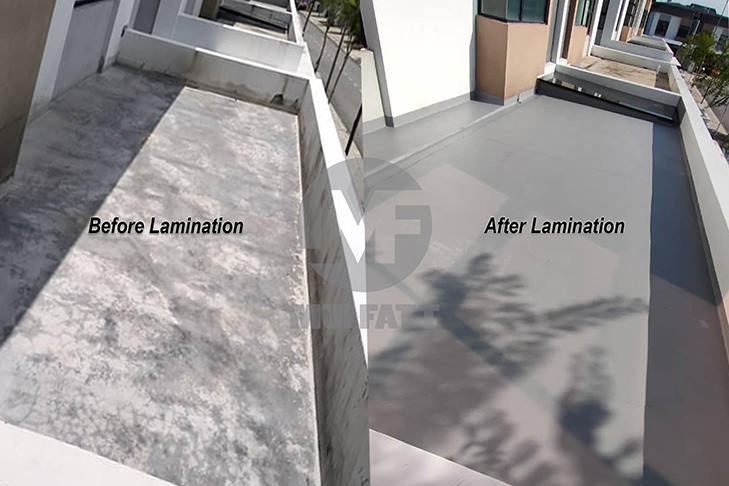
Common Types of Conventional Waterproofing Systems
-
Bituminous Membranes
-
Torch-applied or self-adhesive sheets.
-
Prone to delamination and UV degradation over time.
-
Requires protective screed or coating for UV protection.
-
-
Cementitious Coating
-
Easy to apply and affordable.
-
Rigid and brittle — cracks under substrate movement.
-
Used mostly for internal wet areas with minimal structural stress.
-
-
Polyurethane (PU) Coating
-
Offers good flexibility and crack bridging.
-
Aromatic PU degrades under UV; aliphatic PU is UV-resistant but expensive.
-
Moderate chemical resistance and requires regular maintenance.
-
FRP vs Conventional Waterproofing
| Feature | FRP Lamination | Bituminous Membrane | Cementitious Coating | PU Coating |
|---|---|---|---|---|
| Seamless Application | ✅ Yes | ❌ No (requires overlaps) | ⚠️ Partial (multiple coats) | ✅ Yes |
| Chemical Resistance | ✅ Excellent | ❌ Low | ❌ Low | ⚠️ Moderate to High* |
| Structural Reinforcement | ✅ Yes | ❌ No | ❌ No | ❌ No |
| Durability in Wet Areas | ✅ Excellent | ⚠️ Moderate | ❌ Poor | ⚠️ Moderate |
| UV Resistance | ✅ High | ❌ Poor | ❌ Poor | ⚠️ Depends on PU grade |
| Crack Bridging | ✅ Excellent | ❌ No | ❌ No | ✅ Good |
*Note: Aliphatic PU has better UV and chemical resistance but comes at a higher cost.
Benefits of FRP Lamination
-
Durability: Withstands wear, moisture, and corrosion.
-
Chemical Resistance: Ideal for use in wastewater, aquaponics, and industrial plants.
-
Structural Strength: Reinforces the surface it bonds with.
-
Seamless Finish: No joints, overlaps, or leakage points.
-
UV and Heat Resistance: Suitable for exposed rooftops and external walls.
Where is FRP Waterproofing Used?
-
Flat rooftops and balconies
-
Aquaponic systems and hydroponic tanks
-
Wastewater treatment plant walls and ceilings
-
Storage tanks, sumps, and pits
-
Restroom ceilings and public infrastructure
Project Reference: FRP Lamination at Bandar Utama
In 2022, Mui Fatt completed a major FRP lamination project for Bandar Utama City Assets Sdn. Bhd., covering 14 floors of a 28-storey building.
-
Area covered: ~17,000 sqm
-
Purpose: Aquaponic multilevel high-rise farming system
-
Duration: 3 months
-
Outcome: Zero leaks, chemical resistant, structurally sound
Read full project case study - FRP Lamination for Aquaponic System at Bandar Utama
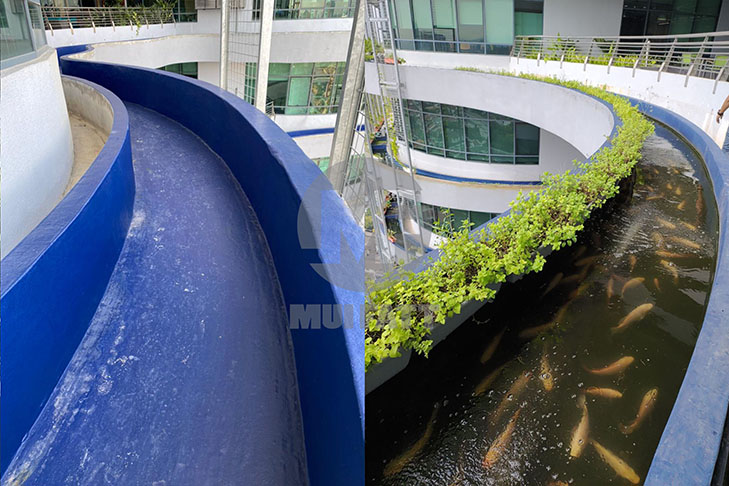
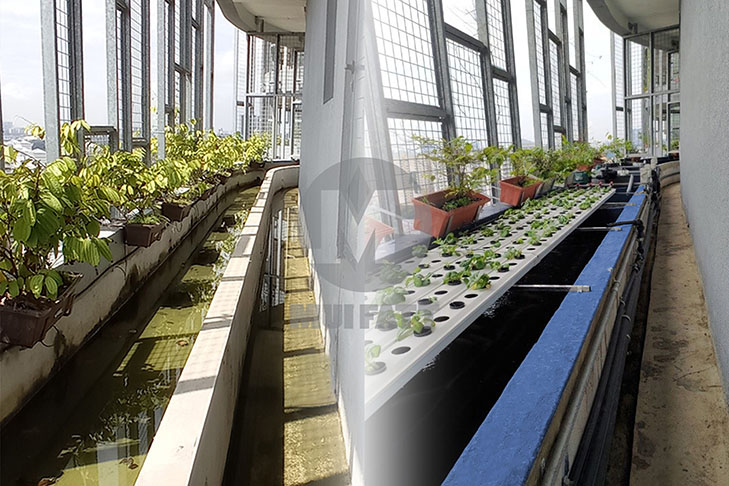
FRP lamination may initially seem niche, but it is quickly becoming a preferred waterproofing method in Malaysia. Its seamless, high-performance, and long-lasting nature makes it the smart choice for modern infrastructure, especially in chemically or moisture-exposed environments.
Frequently Asked Questions (FAQs)
How long does FRP lamination last?
When properly applied using quality resin and reinforcement, FRP lamination can last 20–30 years or more, especially in protected or indoor environments. It requires minimal maintenance compared to membrane-based systems.
Can FRP be applied over existing coatings?
Yes, FRP can be applied over existing coatings or surfaces, provided the substrate is structurally sound, clean, dry, and properly prepared (e.g., through mechanical abrasion or degreasing).
Is FRP lamination safe for potable water zones?
FRP can be made safe for potable water use when food-grade resins (like vinyl ester or isophthalic polyester) are used. Make sure to specify this during design and fabrication.
Does FRP require regular recoating like PU?
FRP forms a solid, chemically bonded layer that doesn’t degrade like PU coatings. Unlike PU, which needs recoating every 5–7 years in harsh conditions, FRP remains intact for decades when properly maintained.
Is FRP lamination suitable for exposed outdoor areas?
Yes. FRP offers excellent UV resistance (especially with gelcoat or pigmented topcoats) and is commonly used in rooftops, wastewater plants, and chemical storage areas.
Can FRP lamination be repaired if damaged?
Yes. Localized damage can be easily repaired by sanding, reapplying resin and mat, and blending the area. It does not require a full system replacement like membrane systems.
How long does FRP lamination take to install?
Installation timelines vary, but for typical flat slab applications, it may take 1–2 days per 100–200 sqm, depending on the surface condition, number of layers, and curing time.
Does FRP lamination emit strong fumes during installation?
Yes, some resins (like polyester or vinyl ester) emit styrene vapors. Proper ventilation and PPE (personal protective equipment) are essential. Odor dissipates after full curing.
#FRPwaterproofing #FRPlaminationMalaysia #waterproofingsystemcomparison #fiberglasswaterproofing #PUvsFRP #bituminouswaterproofing
Disclaimer:-
The content on this site is for general information and entertainment purposes and does not constitute legal counsel. We strive to keep our information as accurate as possible. However, we make no warranties about the completeness, accuracy, reliability, suitability, or availability with respect to the information contained on this page. You should rely on this information at your own risk. This website may include links to other third-party sites. These links are provided as a convenience to you as a reader, user, or browser only. We make no representation, warranty, or guarantee, nor do we endorse or take responsibility for any of the content of such sites.
Stay in touch with us if you’re interested in hearing from us promptly.
- Website - https://www.muifatt.com.my/home/
- Facebook - https://www.facebook.com/muifattmarketing
- Instagram - https://www.instagram.com/muifattmarketing/
- Google - https://goo.gl/maps/WxVY13gNcaRTS7Jp6
- Youtube - http://www.youtube.com/@MuiFattMarketing
- TikTok - https://www.tiktok.com/@muifattmarketing
- LinkedIn - https://www.linkedin.com/company/mui-fatt-marketing-sdn-bhd-
- Linktree - https://linktr.ee/muifattmarketing
- Shopee - https://www.shopee.com.my/muifattmarketing
- Lazada - https://www.lazada.com.my/shop/mui-fatt-marketing
Recent Blog
Mui Fatt Engineering Insights - FRP Panel Tank Installation
Get to know the step-by-step assembly process of FRP sectional panel tanks, based on Mui Fatt’s industry-proven practices. This easy-to-digest guide is ideal for project managers, contractors, and technical personnel involved in water storage tank installation across Malaysia.
FRP Panels vs Traditional Alternatives: The Ultimate Guide to Durability and Sustainability
Explore why FRP (Fiberglass-Reinforced Plastic) panels outperform traditional materials like steel, plywood, and PVC in durability, sustainability, and cost-effectiveness. Discover real-world applications in MyKiosk projects and cold truck panel assembly, where FRP’s superior insulation, corrosion resistance, and lightweight properties deliver long-term benefits.
Benefits of FRP in Food Handling & Processing
With hygiene, durability, and corrosion resistance at its core, FRP (Fibreglass Reinforced Plastic) is becoming a preferred material in the food industry. This article explores why FRP is ideal for food handling equipment such as supermarket fish trays, water tanks, and food factory platforms, plus how Mui Fatt is delivering proven solutions through its successful FRP applications.
Mui Fatt Insights: Advanced Materials for Modern Needs
Is stainless steel the best for wet areas? This article explains why more industries are switching to FRP for its corrosion resistance, hygiene benefits, and longevity, especially in food displays and chemical exposure zones.
How FRP Supports Modern Data Center Infrastructure
Discover how fiberglass-reinforced plastic (FRP) is reshaping data center construction. Learn its key advantages, comparisons with other materials, and where to apply FRP—from rooftop chillers to cooling tanks.
Understanding FRP Filament Winding: Process, Benefits & Comparison
This article explores the FRP filament winding manufacturing method, how it differs from other FRP techniques, why it’s still widely used, and its long-term value for projects like high-strength tanks and cylinders.
Rust Problems? Discover Why FRP Roofing Is the Superior Choice
Tired of dealing with rusted roof panels? Learn how FRP roofing offers a corrosion-free, custom-fit solution — and why it outperforms metal for industrial environments.
